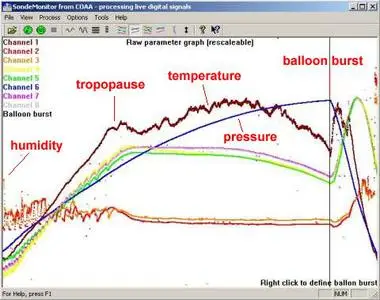COAA SondeMonitor 6.2.8.2 | 2.8 Mb
SondeMonitor tracks and decodes live weather data telemetry from radiosonde weather balloons.
Features
Analogue and digital sondes
SondeMonitor decodes the messages from both analogue (6-tone) radiosondes (Vaisala RS80 series) and digital radiosondes (Vaisala RS92SGP and RS92AGP series) using a simple UHF scanner receiver and the soundcard of a PC or laptop.
Data output
SondeMonitor generates a data file of the raw sample frequency data from analogue radiosondes and the raw hex data from digital radiosondes.
Raw display
SondeMonitor displays the raw measurand data in either table form or graphical form as a quick look and to identify the balloon burst instant.
Graphical displays
SondeMonitor displays the decoded data in either table form or graphical form (right). A median filter and a smoothing filter are both supplied to improve the signal to noise ratio of the telemetry from analogue sondes that lack the error checking machanisms of the digital sondes.
Stueve diagram
SondeMonitor can display the decoded telemetry data from a digital sonde in a real-time using a Stueve diagram (below right) that develops as the sonde ascends. The diagram shows temperature and humidity against log pressure (altitude) together with measured wind data if the GPS telemetry decode is armed.
GPS position tracking
SondeMonitor can display a map showing the ground track of digital (GPS) radio sondes during their flight mission or processed from the telemetry data afterwards (right) It can also ouput the current sonde position as a pseudo-GPS receiver in serial NMEA format.
System Requirements:
Pentium level PC running WinXP/Vista/7/8.1/10 with a compatible sound card.
UHF receiver and antenna capable of receiving WFM mode (analogue) or NFM mode (digital) on UHF frequencies between 400 and 406 MHz. For reception of the RS92AGP sondes (currently used in Germany), you need a receiver with a discriminator output.
Compatible radiosonde launches within UHF line of sight (up to 300km).
Home Page - https://www.coaa.co.uk/sondemonitor.htm



